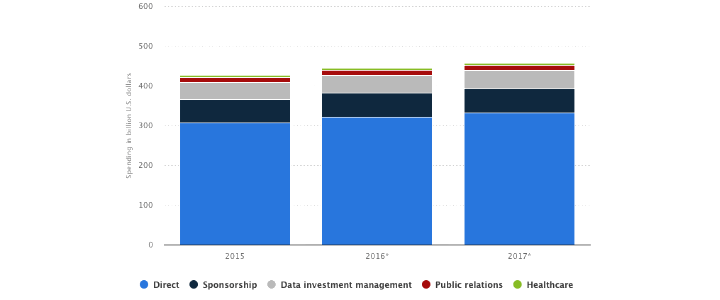Average Marketing Spending Percentages By Category
 Right now, there’s a strong chance you’re crunching numbers to see where your 2018 marketing budget stands. During this process, it can be helpful to take a closer look at what others are allocating to each category within their marketing budget. Today, we’re going to do just that.
Right now, there’s a strong chance you’re crunching numbers to see where your 2018 marketing budget stands. During this process, it can be helpful to take a closer look at what others are allocating to each category within their marketing budget. Today, we’re going to do just that.
The State of Marketing Budgets in General
As companies expand their efforts to reach consumers in new and meaningful ways, we’ve seen record spending on marketing in the past few years. That trend shows no sign of curtailing anytime soon.
The 2016-17 edition of Gartner’s CMO survey showed the third consecutive year of budget increases across to board. The largest, highest grossing companies in the world saw their marketing budgets balloon to 13% of total revenue, while smaller companies continued to allocate about 10% of gross revenue to marketing expenses.
Keep in mind, that these numbers can vary widely from industry to industry. For example, consumer goods and services manufacturers tend to allocate a much more substantial portion of their overall budget towards marketing expenses, to the tune of 15-24%. Meanwhile, in categories like energy or manufacturing, companies dedicate a much smaller portion of their budget towards marketing expenses.
Despite the fact that most marketers are seeing their budgets grow year after year, this past year, more companies began bracing for budget cuts compared to the year prior. In 2014-15, only 3% of marketers expected to see budget cuts. Meanwhile, that number increased to 14% in 2015-16. Time will tell if more companies are going to consider tightening their belts in 2018. But, as a whole, you can expect to see continued growth in marketing budgets.
As for hard numbers, marketing budgets increased by just shy of 30 billion dollars from 2015 to 2017, according to Statista. In 2017, companies dished out over 455 billion dollars in marketing expenses. Forecasting suggests that marketing budgets will achieve record highs in 2018 and total spending will fall just shy of the 500 billion dollar mark.
If you’re currently unsure of what your budget is going to look like in 2018, this handy marketing budget calculator can provide you with some help in that department, which should help make your 2018 a bit more clear.
Continued Rise of Digital
Digital marketing expenditures have gone through the roof over the past few years. That trend doesn’t show any sign of changing. Spending on digital initiatives such as websites, e-commerce, and digital advertising all increased in 2017, and forecasts suggest those numbers will continue to rise in 2018.
Regardless of whether your business is consumer facing or B2B, investments in e-commerce accounted for about 8% of total marketing budgets in 2017. Based on consumer buying trends, companies will continue to invest in different ways to reach their consumers in a transactional way.
Website spending also increased dramatically in 2017. According to Gartner, 9% of marketing budgets went directly to website development or improvements. This is up 14% from 2016. As marketers continue to prioritize user experience and look for ways to provide a web experience with more personalization and utility than ever before, expect marketers to double down and continue to invest more of their budgets into website improvements.
Perhaps the area where marketers are most likely to allocate a more substantial portion of their marketing budgets is digital advertising. Nearly two-thirds of marketers increased their digital advertising budgets last year.
This increase came in spite of the growth of ad-blocking software, and the public’s growing disinterest when it comes to engaging with advertising. Despite these caveats, companies continue to move higher portions of their marketing budgets to the digital space.
This is an area you can expect to see increase even further in 2018, and the reasoning is threefold.
First, companies will continue to divert money they once spent on traditional marketing tactics in favor of digital initiatives. Next, the importance of video became even more evident in 2017, and that trend looks like it will continue into 2018. Producing video content is often more expensive than providing other forms of content, and it contributes to an increased bottom line. Finally, with regards to social media platforms, it can be more expensive to get the video content you’ve just produced in front of consumers, which also contributes to higher increases.
 Tim Brown is the owner of Tim B Design, and is a web designer and SEO Specialist out of Minneapolis, Minnesota. You can check out his recent project “The Marketing Budget Calculator” to plan your marketing budget for this next year and take a look at his blog to learn cutting-edge methods to get the most out of your digital marketing budget. Tweet him at @timbdesignmpls
Tim Brown is the owner of Tim B Design, and is a web designer and SEO Specialist out of Minneapolis, Minnesota. You can check out his recent project “The Marketing Budget Calculator” to plan your marketing budget for this next year and take a look at his blog to learn cutting-edge methods to get the most out of your digital marketing budget. Tweet him at @timbdesignmpls















